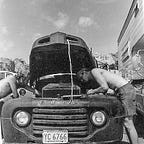This Day in History
June 8th
1967 — USS Liberty attacked. The US communications ship was attacked by Israeli warplanes and torpedo boats. 34 Americans were killed and 171 wounded. The ship had been under surveillance by Israeli forces for nine hours before the attack. The attack took place during the Six-Day War and Israel has always maintained that it was a case of mistaken identity. They thought it was an Egyptian transport ship. This despite the facts that the Liberty was sailing in international waters, flying the American flag, and was twice the size of the transport ship. The attack came in two assaults. Over 30 sorties were flown by as many as a dozen planes firing cannons and rockets, followed by boats launching torpedoes into the Liberty’s hull and then machine gunning those trying to fight the fires, and even firing on lifeboats launched to help the wounded.
Those aboard the ship and many in the Navy are convinced the attack was deliberate. The resulting investigations were conducted in a way to clear Israel. Pressure was put on President Johnson and Congress to protect the alliance between the two nations by sweeping the incident under the rug. The Liberty was a lightly armed ship with only four 50-caliber machine gun mounts. It was a communications ship, or as some could view it, a spy ship. Their mission was to monitor Egyptian and Russian communications in order to assist Israel if necessary. Some maintain that Israel thought their own communications were being monitored, took exception and this provoked the attack.
Another puzzling aspect was that the Liberty was left defenseless by the U.S. Navy. The captain had requested a destroyer escort but that request had been denied. He was told that if he got into trouble jets from the 6th Fleet could reach him in ten minutes. The Liberty did radio for help, the fighter jets were scrambled, and then recalled. The thought of Israeli and American jets dueling over the Mediterranean was too unsettling.
“Chief Petty Officer J.Q. “Tony” Hart, who monitored conversations between then-Defense Secretary Robert McNamara and Sixth Fleet Carrier Division Commander Rear Admiral Lawrence Geis, reported McNamara’s instructive reply to Geis, who had protested the order to recall the U.S. warplanes on their way to engage those attacking the Liberty. McNamara: From consortiumnews.com: “President Johnson is not going to go to war or embarrass an American ally (sic) over a few sailors.” The Vietnam War was also going on at this time with several hundred soldiers being killed each week so apparently a handful of naval fatalities wasn’t that big a deal.
No defensive action, no retaliation, a slipshod inquiry, and after the initial reporting, no in-depth press coverage, as if even that was suppressed.
I was standing in line one day, waiting not so patiently to enter the chow hall. I was surrounded by other sailors, most of whom, given the complaining going on, were not happy with their current existence. I was aware that my life at the moment was not normal. For one thing I had pretty much relinquished control over which direction it would take. The Navy had chosen to train me to be a radioman, and there was a fair amount of time and money being put into that effort. It occurred to me at the time that payback would be expected. And that payback had the potential to be unpleasant. There were dozens and dozens of training facilities throughout the nation producing whatever the Navy needed. It was like a massive assembly line and they just kept churning us out, filling that need. Then a different, even silly, imagery took hold. That of a shooting gallery. Every carnival or arcade in those days had one. Little yellow ducks on a conveyor passing left to right before a shooter with an air rifle. When the shooter was on target the little yellow duck would be plunked over. For the term of our enlistments, that’s all we were, little ducks. I just had to hope there would be no shooting going on while I took my turn on the conveyor line.
A cartoonish application for a serious matter, I know, but hey, I was eighteen. I got lucky and there were no paying customers during my time on the conveyor. The sailors aboard the USS Liberty were not so lucky. They were killed, wounded, and traumatized, abandoned at the time of the attack and conveniently forgotten afterwards.
At the time I was very interested, and aghast, over the attack, and then puzzled at how quickly it passed through the news cycle and nothing more was heard. From the books I’ve read on the subject I’m convinced the attack was knowing and deliberate. Why, I’m not sure. Maybe some rogue elements within the Israeli military. And since no real investigation was ever done those elements were protected rather than exposed. Higher priorities were at stake and a real life deadly shooting gallery did not matter. As in most conflicts, those doing the dying were not the main issue. My immature imagery in chow line that day was not so far off.
Birthdays:
1831 — Thomas Higgins. Medal of Honor winner. He was a flag bearer in a Union assault on the Confederate ramparts at Vicksburg. A massive volley decimated the Union ranks. As the smoke cleared only one man, Higgins, carrying the Union colors, marched forward alone. A hundred Rebel rifles were leveled at him. They fired, and somehow, miraculously, all missed. Higgins continued forward. And then an amazing thing happened. The Rebels, in awe, stopped shooting, and a loud cheer rose from their ranks. He reached the enemy’s position, was captured, and welcomed with handshakes. It was partly at their insistence that he was awarded the Medal of Honor. Higgins was later paroled back to the Union Army and he survived the war.
Unlike those aboard the Liberty, Higgins’s valor was recognized.
Sources:
consortiumnews.com
civilwartalk.com
onthisday.com
